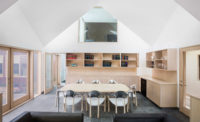As the sixth anniversary of the terrorist attacks on September 11, 2001, approaches, memorials are rising around the country. Boston is planning a structure for Logan Airport, where the two planes that hit the Twin Towers originated. Designed by Moskow Architects, the 2-acre park containing benches and ginkgo trees is focused around a “Palace of Remembrance”: a laminated glass-and-steel cube that measures 20 feet on each side. Inside the cube, which has no doors or roof, a pair of plaques will be inscribed with the names of the airplanes’ passengers and crew. Different-size laminated glass pieces will dangle from cables overhead, swaying in the breeze like a mobile. It sits on a slight rise of land within sight of Logan’s terminals: a stipulation of the client, the Massachusetts Port Authority. “It needed to be uplifting, to speak to the positive response to an unspeakable tragedy,” explains architect Robert Linn, AIA. The $4 million project is set to break ground this September 11, with completion one year later.
Work is already progressing on the memorial at Ground Zero in Manhattan; its footings were poured in May. One-and-a-half miles north of the site, another 9/11 memorial is in the offing at St. Vincent’s Hospital. During the attacks, this hospital was a command center for triage efforts. Afterward, its exterior walls became a de facto bulletin board for hundreds of missing-persons fliers. The original signs were archived, but plastic-covered facsimiles went up in their place.
Stamberg Aferiat Architecture, with Ghiora Aharoni, will recreate this flier wall as the centerpiece of a memorial on a triangular, quarter-acre strip of land across the street from the hospital. Plans call for two, 90-foot-long, stainless-steel walls, each 14 feet high, to run parallel to each other separated by an 8-foot-wide path. The fliers will hang on the rear wall; beneath them, a metal panel will be etched with their images so that when the papers eventually disintegrate they reveal permanent versions. “So many of the September 11th memorials have become so huge that they no longer have the sense of the people who were lost,” says Peter Stamberg, AIA. “We wanted to keep the immediacy of the original flier-wall tribute.” Despite support from the hospital’s staff, the $5 million project has been hampered by slow fund-raising and uncertainty over whether or not St. Vincent’s might move.
Paper and other ephemera also inspired a memorial to terrorist victims in Spain. The city of Madrid unveiled a $6 million structure dedicated to the 191 people killed in attacks on March 11, 2004. Located on a traffic island across from the Atocha train station, where four bombed trains were heading, it is defined by a 35-foot-tall tower of glass blocks coated with a polymer membrane. Painted along the tower’s inside walls are messages taken from condolence cards placed at a makeshift memorial. Visitors gaze upward from a below-grade room that is painted dark blue, to contrast with the streaming sunlight from above. “A train station is not necessarily the best site for a memorial, since it’s so functional,” says Miguel Jaenicke, a partner of the architect Estudio F.A.M. “But in Madrid, we enjoy really good skies, so we used natural light to create a special room.”










Post a comment to this article
Report Abusive Comment